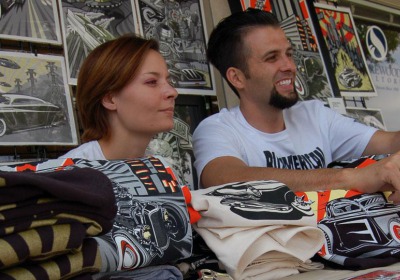New generation of car kulture shows up at art and hot-rod show
Wed, 13 May 2009
It's not about cars so much as it's about art. Or it's about cars imitating art. Or vice versa. The car as canvas. Ultimately, it may be the future of hot-rodding, since those of us who still remember typewriters and black-and-white television won't be around forever.
The next generation of hot-rodders could well be the guys and gals we saw Saturday at Gasoline Gallery's fourth-annual California Screamin', an "Art and Hot Rod Show" held on the blocked-off Main Street of the SoCal beach city of El Segundo. They can weld, paint and bend metal into shapes they find appealing, shapes that look somewhat like what an older generation calls a hot rod, but with their own unique twist.
Instead of '32 Ford Hi Boys, you're more likely to see low boys, rides that scrape the ground. Instead of 17 layers of glossy enamel cherry red that shines so brightly it could be plugged in to a nearby outlet, the flavor here is flat finish, usually black but sometimes fetching shades of red or brown. Or even no paint at all, rides that look to be in a constant state of development, but at the same time carry the same kool cachet of the far more finished projects seen at any of a hundred traditional hot-rod shows on any given weekend--just up the coast this same day at the Barris show in Culver City, for instance.
The Rat Rod movement (kulture? hobby? genre?) has been around for 15 years or so and shows no signs of slowing down. Gasoline Gallery has been in business five years and has sponsored this show for the last four.
"I was always a fan of lowbrow art," said Gasoline Gallery owner and founder Mark Waldman, referring to the moniker often assigned to hot-rod artistry.
The gallery holds works of two-dimensional art by a number of names. You can see traces of great artists of the first generation such as Ed "Big Daddy" Roth, Robert Williams and Von Dutch, with Roth being the most influential.
"We have four guys in there who worked for Ed Roth," said Waldman.
He sees the form growing.
"The whole kustom kulture thing has just sort of ballooned," he said. "You can get a lot of rat-rod stuff in every Wal-Mart."
Artist Max Grundy lived in Utah at the same time Roth lived there.
"I talked to Roth at shows from time to time," he said. "We weren't friends by any means, but I got to talk to him about his art."
Grundy also was influenced by stories his dad told him about cars he owned and raced: a '49 Mercury, '40 Ford and '55 Corvette.
"I was always drawing hot rods," said Grundy, who describes his prints and T-shirt art as hot-rod propaganda. "In college, my professors would say, 'Well, you shouldn't really draw hot rods.' They thought it was low art."
At the Grand National Roadster Show two years ago, there was a whole hall reserved for rat rods. At last year's show, there was a rat rod entered in the AMBR competition. The phenomenon doesn't seem to be fading and, as we said, the next generation has to come from somewhere. If it offends traditional hot-rodders, they could consider how their parents felt about what they did 40 or 50 years ago. At least no one's into custom vans.
By Mark Vaughn

